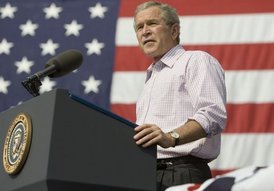
- Afghanistan
- Africa
- Budget Management
- Defense
- Economy
- Education
- Energy
- Environment
- Global Diplomacy
- Health Care
- Homeland Security
- Immigration
- International Trade
- Iraq
- Judicial Nominations
- Middle East
- National Security
- Veterans
- President's Cabinet
- USA Freedom Corps
- Faith-Based & Community Initiatives
- Office of Management and Budget
- National Security Council
- USA.gov
Independence Day ****2005****

Flag Day and National Flag Week, 2006
A Proclamation by the President of the United States of America
From our Nation's earliest days, Old Glory has stood for America's strength, unity, and liberty. During Flag Day and National Flag Week, we honor this enduring American symbol and celebrate the hope and ideals that it embodies.In 1777, the Second Continental Congress established the flag of a young Nation, whose 13 original states were represented in the flag's 13 stars and 13 alternating red and white stripes. Today, the Stars and Stripes commemorate the revolutionary truths of our Declaration of Independence and Constitution. As Americans, we revere freedom and equality, the rights and dignity of every individual, and the supremacy of the rule of law. These fundamental beliefs have guided our country and lifted the fortunes of all Americans, and we have seen their power to transform other nations and deliver hope to people around the world.

Declaration of Independence
IN CONGRESS, July 4, 1776.
When in the Course of human events, it becomes necessary for one people to dissolve the political bands which have connected them with another, and to assume among the powers of the earth, the separate and equal station to which the Laws of Nature and of Nature's God entitle them, a decent respect to the opinions of mankind requires that they should declare the causes which impel them to the separation.
Independence Timeline
1765-1773
The British Parliament bypasses colonial assemblies and imposes several internal and external taxes on the outraged colonists.
Dec. 16, 1773
The colonial response to taxation without representation culminates in the Boston Tea Party. The Sons of Liberty dump 342 chests of tea into Boston harbor.
Sept. 5, 1774
Delegates begin meeting for the First Continental Congress and agree to send grievances to King George III.
April 19, 1775
Armed conflict between the colonists and British redcoats begins in Lexington and Concord, Massachusetts.
May 10, 1775
A Second Continental Congress begins meeting in Philadelphia.
June 11, 1776
The Continental Congress appoints a five-man committee, including Thomas Jefferson, to draft a declaration of independence.
June 28, 1776
The committee presents the declaration for debate and revision.
July 4, 1776
The Continental Congress adopts the Declaration of Independence without dissent.
Photo Essay
Click here to see how the White House Celebrates Independence Day.Related Links
National Archives & Records Administration (NARA)
Library of Congress: Declaring Independence: Drafting the Documents



